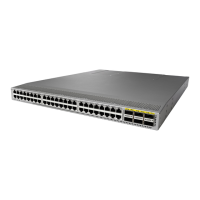Send document comments to nexus3k-docfeedback@cisco.com
8-3
Cisco Nexus 3000 Series NX-OS Unicast Routing Configuration Guide, NX-OS Release5.0(3)U1(1)
Chapter 8 Configuring Static Routing
Licensing Requirements for Static Routing
Remote Next Hops for Static Routes
You can specify the next-hop address of a neighboring router which is not directly connected to the
router for static routes with remote (non-directly attached) next-hops. If a static route has remote
next-hops during data-forwarding, the next-hops are recursively used in the unicast routing table to
identify the corresponding directly attached next-hop(s) that have reachability to the remote next-hops
Virtualization Support
Static routes support Virtual Routing and Forwarding instances (VRFs). By default, Cisco NX-OS places
you in the default VRF unless you specifically configure another VRF. For more information, see
Chapter 9, “Configuring Layer 3 Virtualization.”
Licensing Requirements for Static Routing
The following table shows the licensing requirements for this feature:
Prerequisites for Static Routing
Static routing has the following prerequisites:
• If the next-hop address for a static route is unreachable, the static route will not be added to the
unicast routing table.
Guidelines and Limitations
Static routing has the following configuration guidelines and limitations:
• You can specify an interface as the next-hop address for a static route only for point-to-point
interfaces such as GRE tunnels.
Default Settings
Table 8-1 lists the default settings for static routing parameters.
Product License Requirement
Cisco NX-OS Static routing requires no license. Any feature not included in a license package is bundled with the Cisco
NX-OS system images and is provided at no extra charge to you. For a complete explanation of the Cisco
NX-OS licensing scheme, see the Cisco NX-OS Licensing Guide.
Note Make sure the LAN Base Services license is installed on the switch to enable Layer 3 interfaces.

